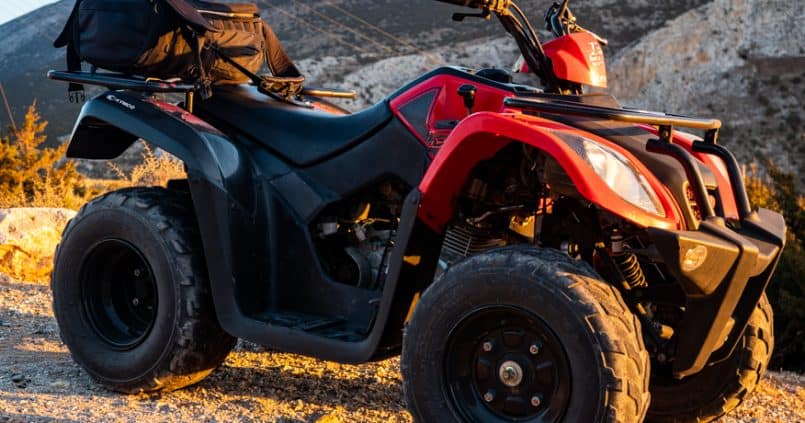Introduction
The Greek islands are a dream destination, each offering a unique blend of beautiful beaches, charming villages, and fascinating history. But once you arrive, how do you get around? Should you rent a car, hop on a bus, or embrace the adventure of a scooter or quad-bike ride? The right choice depends on your budget, travel style, and the island itself.
In this guide, we’ll break down the best transport options across the Greek islands, giving you insider tips on how they work, what they cost, and their pros and cons. With over three decades of firsthand experience exploring Greece, we’ve gathered everything you need to navigate the islands like a pro, so you can spend less time worrying about logistics and more time soaking up the magic of the Aegean.
Getting Around Greek Islands by Bus: The Cheapest & Easiest Option
If you’re looking for an affordable and hassle-free way to get around a Greek island, buses are your best bet. Nearly every inhabited island has a bus network, mainly serving locals but also catering to visitors. During the tourist season (late May to mid-October), extra services are added to keep up with demand, making it even easier to explore.

Where to Find Buses
You’ll typically find the main bus station in the island’s capital, often with a ticket office where you can check schedules and fares. Bus stops are scattered across key locations—ports, airports, villages, beaches, and popular attractions—so getting from A to B is straightforward. Many stops display printed timetables, helping you plan your trip on the go.
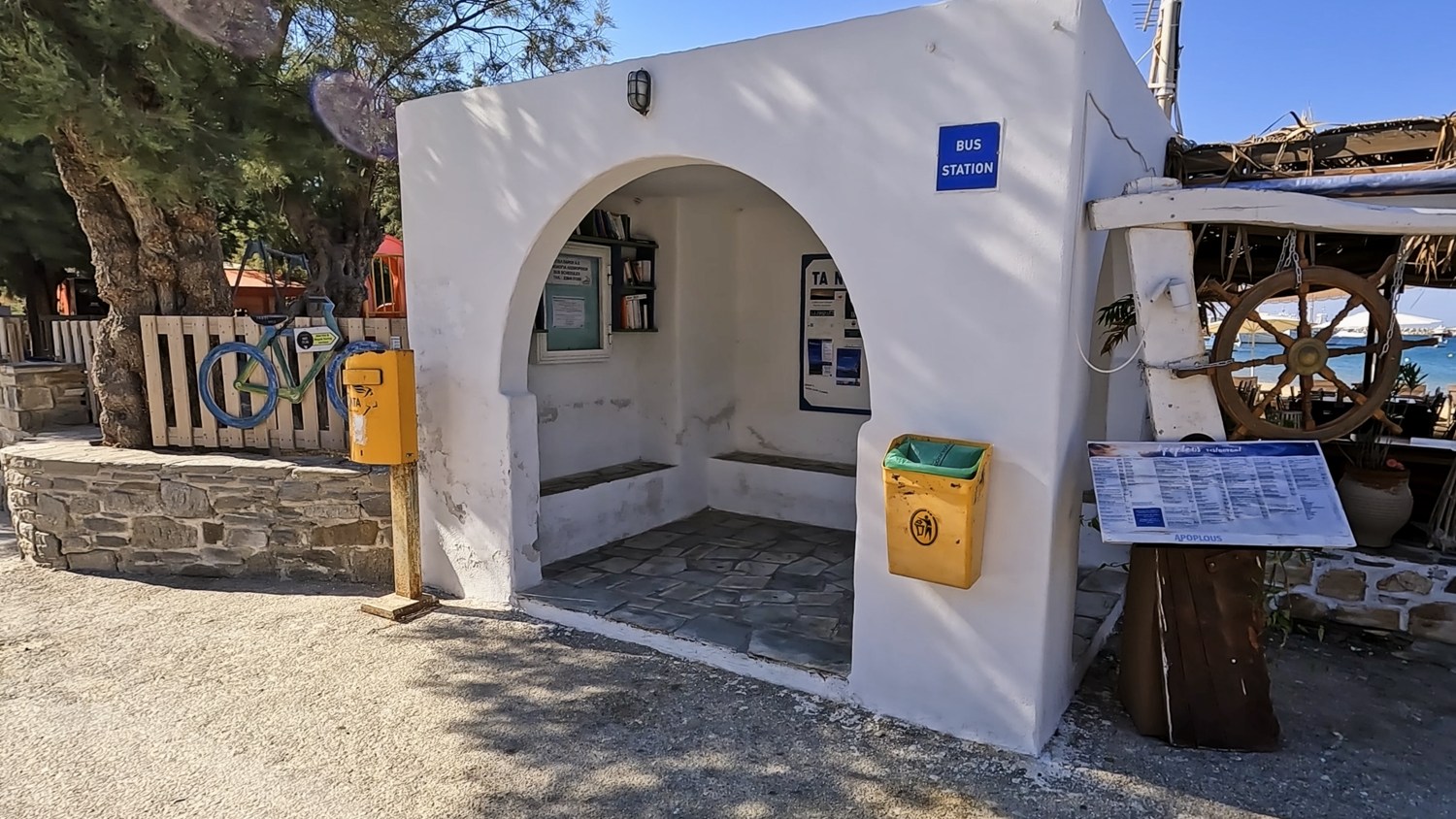
Ticket Prices & Routes
Bus fares vary by route but generally start around €1.80 and go up to €4 on smaller or mid-sized islands. Only larger islands like Crete have more expensive routes due to longer travel distances. Most islands allow you to purchase tickets on the bus, either from the driver as you board, or from a conductor who will make their way down the bus once everyone is seated and charge you based on your destination. It’s unusual for buses to accept card payments, so you’ll want to keep small change available for bus fares.
Some islands, for example, Naxos, require you to purchase a ticket from a kiosk or nearby shop before you board. Make sure to allow extra time to buy tickets ahead of your journey, and if you aren’t sure whether you need to buy them in advance, ask at your hotel or local tourist information centre so you don’t get caught out.
Using Buses to get to/from your Accommodation
If you’re traveling independently rather than through a package deal, you’ll need to arrange your transfer from the port or airport to your accommodation. While some hotels offer paid transfers, budget travelers will find the bus to be the most cost-effective option.
Just store your luggage in the designated compartment—sometimes the driver or conductor will assist you—board the bus, and let the driver know your destination. While they won’t take you directly to your hotel unless it’s on the route, they’ll usually stop at the closest point possible.
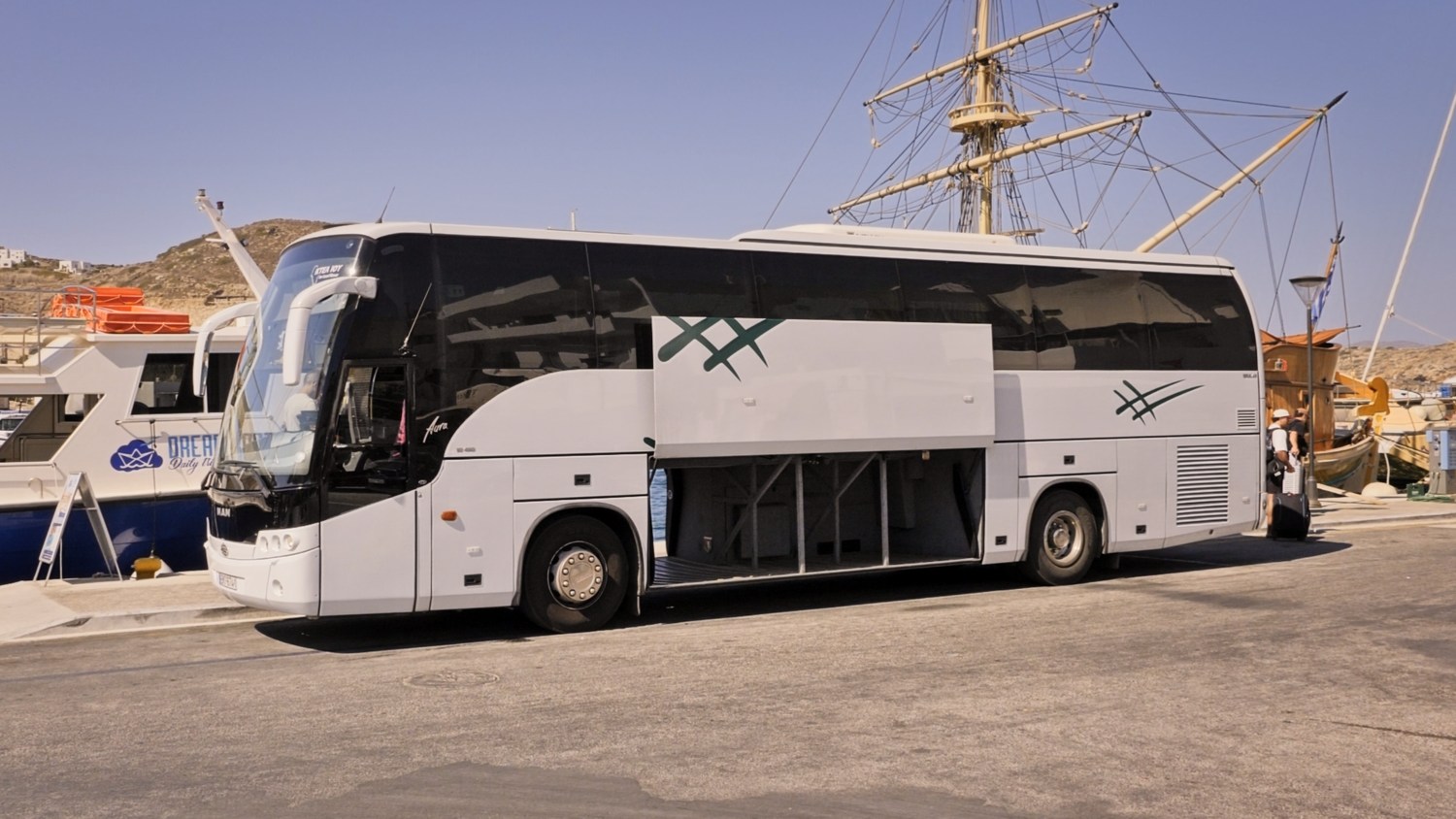
Bus Timetables & Planning Ahead
Most island bus schedules align with ferry arrivals and departures, and they often run to and from the airport, making them ideal for seamless travel. Buses also provide luggage storage free of charge, so you won’t have to worry about extra fees.
Some islands now publish their bus timetables online, but many still don’t—or only release current schedules. Checking in advance can give you a rough idea of available routes. Once you arrive, your accommodation may have a printed timetable at reception, or the staff will likely be familiar with the schedule and can point you in the right direction.
Taking the local bus isn’t just a budget-friendly choice—it’s a great way to experience the island like a local while keeping your travel costs down. 🚍🇬🇷
Getting Around Greek Islands by Taxi: What You Need to Know
Taxis are a convenient way to get around most Greek islands, offering a quicker and more direct alternative to buses. Whether you’re heading to your hotel from the airport or exploring the island’s hidden gems, taxis can be a great option—if you know how to use them effectively.
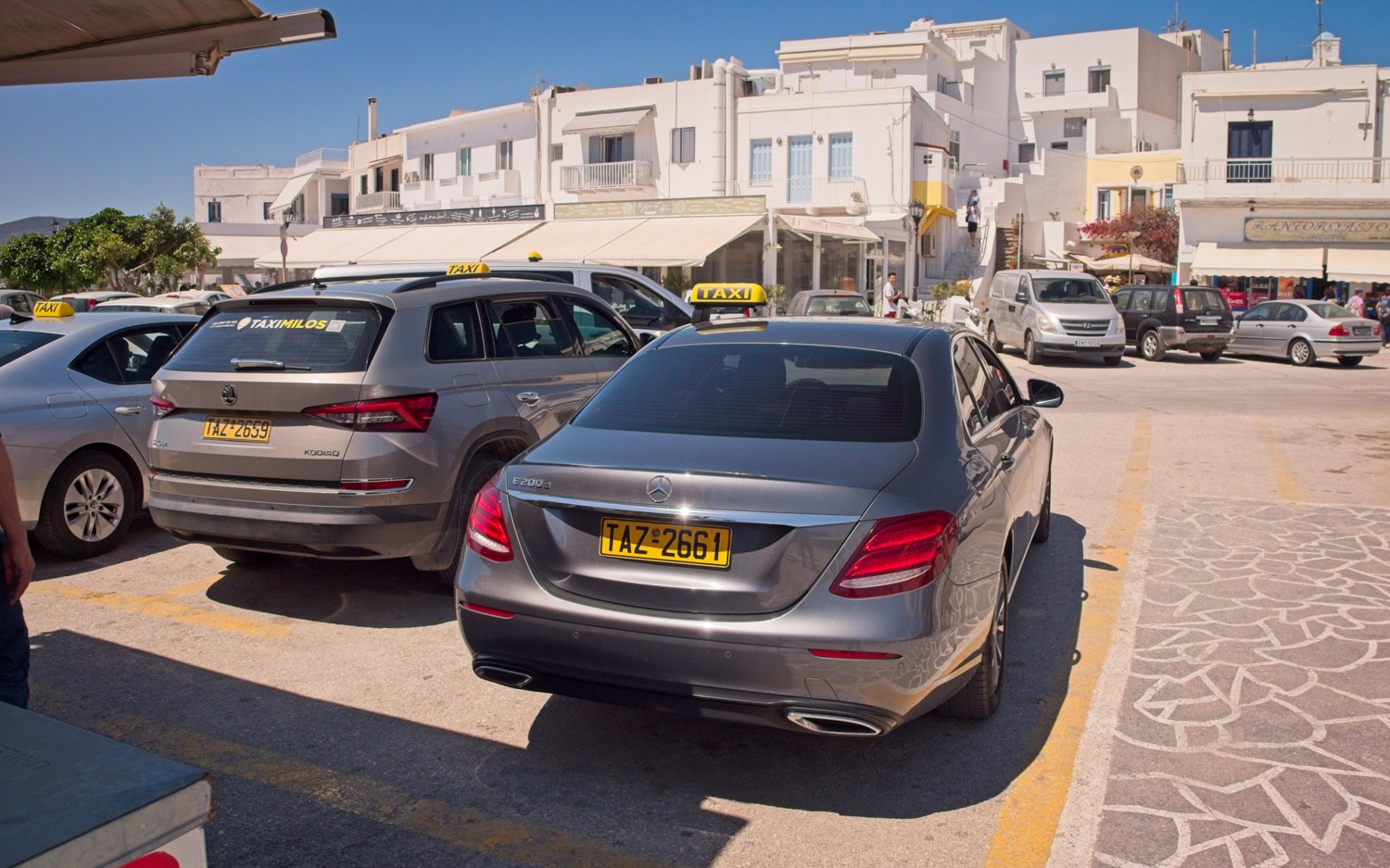
Availability & Demand: Plan Ahead in Peak Season
Most Greek islands have a fleet of taxis serving both locals and tourists. However, popular destinations like Mykonos and Santorini often struggle with demand during peak season (June to September). Finding an available taxi can be tricky, especially at busy times like late evenings or when cruise ships arrive.
To avoid long waits, consider these options:
✔ Pre-book a taxi in advance if you know your arrival time.
✔ Use private transfer services offered by hotels or local companies.
✔ Check for shared taxi services, which some islands offer to help manage demand.
Taxi Fares & Pricing: What to Expect
Taxis in Greece are relatively affordable, especially when shared between three or four passengers. Here’s a general idea of pricing:
💰 Short journeys (within town or nearby beaches): €10-20
💰 Longer trips (cross-island or remote areas): Prices vary but are usually fixed.
Most taxis operate on a fixed-price system, meaning you’ll know the cost upfront. While overcharging is rare, it’s always smart to ask for the price before getting in to avoid any surprises.
If you need a fare estimate, ask at your hotel or a local restaurant—they’ll usually have a good idea of standard taxi prices and can even book one for you.
Where to Find a Taxi
🚖 Ports & Airports – Taxi ranks are usually located just outside the arrival areas.
🚖 Island Capitals & Major Villages – You’ll find taxi stands in central locations.
🚖 Hotels & Restaurants – Staff can call a taxi for you if needed.
If there’s no taxi at a stand, look for a printed list of driver phone numbers, which is common in smaller villages. You can call a driver directly to arrange a pickup.
Ride-Hailing Apps: Are Uber & Lyft Available?
Don’t expect Uber or Lyft on the islands—they’re mostly limited to Athens and a few larger mainland cities. On the islands, taxis must be booked the traditional way, either by phone, in person, or through your accommodation.
Tipping & Payment Etiquette
Tipping isn’t required, but it’s appreciated—especially if the driver helps with luggage. A good rule of thumb is to round up the fare (e.g., if your ride costs €12, pay €15). Cash is the most common payment method, though some taxis now accept card payments—just ask in advance to be sure.
Final Tips for a Smooth Taxi Experience
✅ Confirm the price before you ride to avoid misunderstandings.
✅ Carry cash, as not all taxis accept cards.
✅ Book ahead in peak season to avoid long waits.
✅ Check with locals for fare estimates and reliable taxi contacts.
Whether you’re zipping across the island or heading to a remote beach, taxis offer a comfortable way to get around—just be prepared, especially during the busy summer months! 🚖🇬🇷
Exploring Greek Islands by Bike & E-Bike: A Budget-Friendly Adventure
For those who love the freedom of exploring at their own pace, bicycles are an excellent and eco-friendly way to get around the Greek islands. Whether you’re cruising along scenic coastal roads or venturing into charming villages, biking lets you soak in the landscape while staying active.
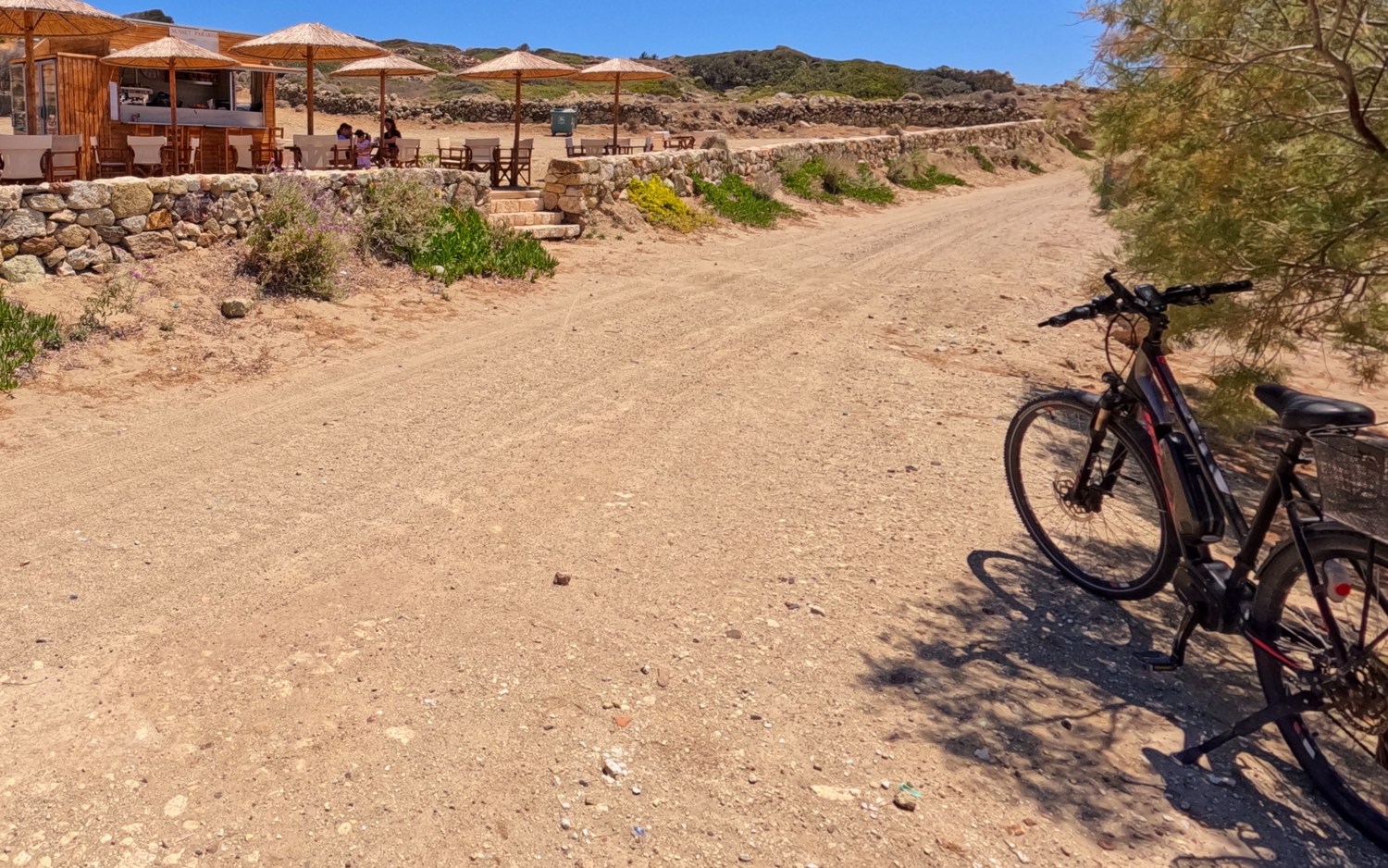
Bike & E-Bike Rentals: What to Expect
🚲 Standard Bikes – The most affordable way to explore, with rental prices starting at around €10 per day. Perfect for flat or lightly hilly islands.
⚡ E-Bikes – Equipped with an electric motor to assist with climbs, e-bikes make island exploring easier. They cost more, typically starting from €20 per day, but save you the effort of pedaling hard up steep roads.
While not all islands have e-bike rental shops, most tourist-friendly destinations do. Prices are comparable to moped rentals (without the fuel costs), making e-bikes a great alternative for those who want some assistance on hills.
Considerations: Is a Bike Right for You?
Bikes provide access to remote areas and off-the-beaten-path locations, but there are a few things to keep in mind:
☀ Heat & Sun Exposure – Cycling in peak summer can be exhausting due to high temperatures, so plan rides for early morning or late afternoon. Wear sunscreen and carry plenty of water to stay hydrated.
⛰ Hilly Terrain – Many islands have steep inclines, making biking challenging if you’re not in great shape. E-bikes help, but they still require some effort.
🛑 Traffic & Road Conditions – Some islands have narrow, winding roads shared with cars, so stay alert and cycle safely.
Taking Bikes on Ferries
Most Greek ferries allow bikes free of charge (for example, when traveling between Milos and Kimolos), but it’s always best to double-check with the rental shop before planning a multi-island biking adventure.
Bike Rental Tips: What to Check Before You Ride
Before setting off, ensure your bike is in good condition by checking:
✅ Brakes – Test both front and rear brakes.
✅ Tyres – Look for proper inflation and no visible damage.
✅ Chain & Gears – Make sure they shift smoothly.
✅ Helmet – Most rental companies provide one, and it’s highly recommended to wear it.
For e-bike rentals, make sure:
🔋 The battery is fully charged before you leave.
🔌 A charger is included if you’re renting for more than a day.
🔎 Check the battery range (usually 10-30 km, depending on terrain and usage).
Luggage & Storage
One drawback of biking is limited storage. Some rental bikes come with:
🎒 Front baskets – Ideal for small bags.
🔗 Rear racks with bungee cords – Can secure light items.
💼 Backpacks – The best way to carry essentials securely.
If you’re planning a full-day trip, pack light and bring plenty of water, sunscreen, and a hat to stay comfortable while riding.
Biking is one of the most affordable ways to explore Greek islands while staying active. While not ideal for every traveler, it’s a great choice for those who enjoy slow travel, scenic views, and a bit of adventure. If you’re worried about hills, e-bikes make it easier to cover ground without breaking a sweat. Just check rental conditions, prepare for the heat, and ride safely—then enjoy the journey! 🚲🇬🇷
Exploring Greek Islands by Moped & Motorbike: Freedom on Two Wheels
If pedaling around in the Greek sun isn’t your thing, a moped or motorbike is the next most affordable option. Offering the same freedom as a bicycle—but with the convenience of speed and no physical effort—these vehicles let you cover greater distances in less time, making them perfect for larger islands or quick sightseeing trips.
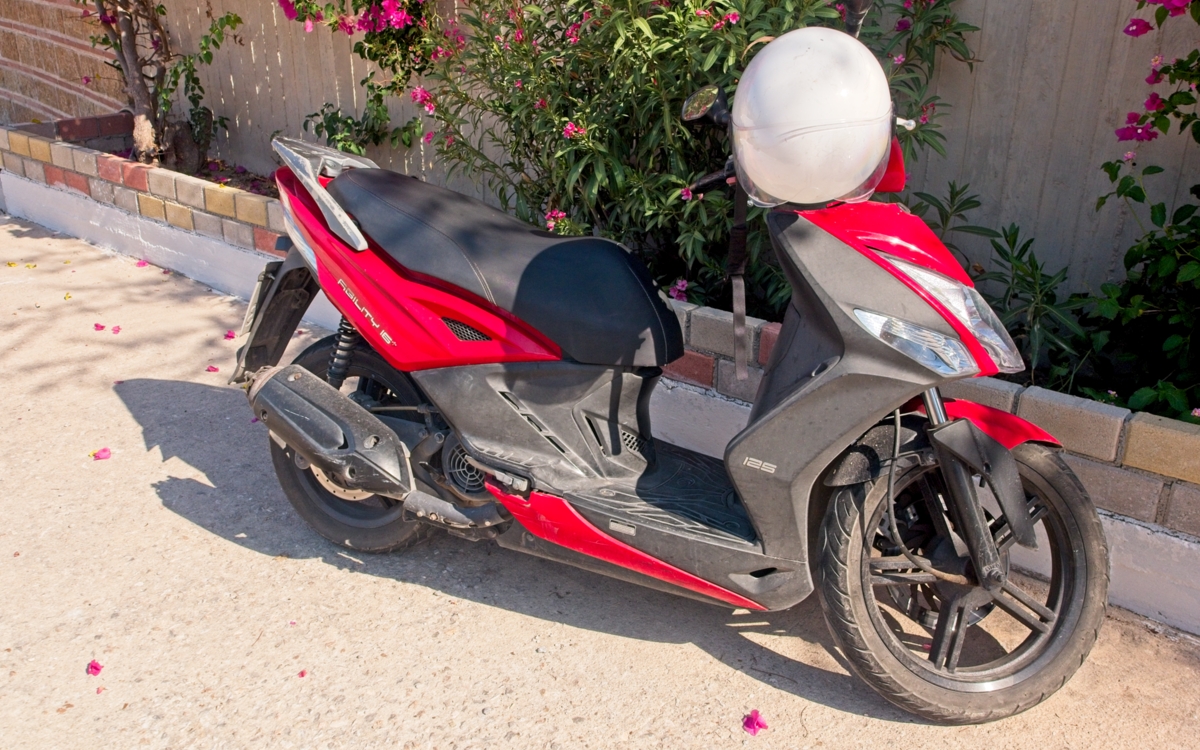
Licensing & Rental Requirements: Do You Qualify?
Before getting excited about zipping through winding coastal roads, check your license requirements. Many Greek islands won’t rent mopeds or motorbikes to tourists unless they have a valid motorcycle license.
✔ EU Licenses – A Category A or A1 motorcycle license is usually required.
✔ Non-EU Licenses – Some rental companies require an International Driving Permit (IDP) in addition to your home license.
✔ No Bike License? – If you don’t meet the requirements, you’ll need to consider renting a car or an ATV instead.
Greek roads can be rough, and accidents involving mopeds are common—so if you’re inexperienced or unsure, it’s best to avoid them and opt for a safer transport option.
Cost & Fuel Efficiency
For those who have the necessary license and experience, mopeds are one of the cheapest motorized transport options:
🏍 Rental prices typically start at €15 per day, significantly cheaper than cars or ATVs.
⛽ Fuel-efficient, meaning you’ll spend less on petrol compared to larger vehicles.
Mopeds are particularly great for solo travelers or couples, though riding with a passenger can make handling trickier, so make sure you’re comfortable with the added weight.
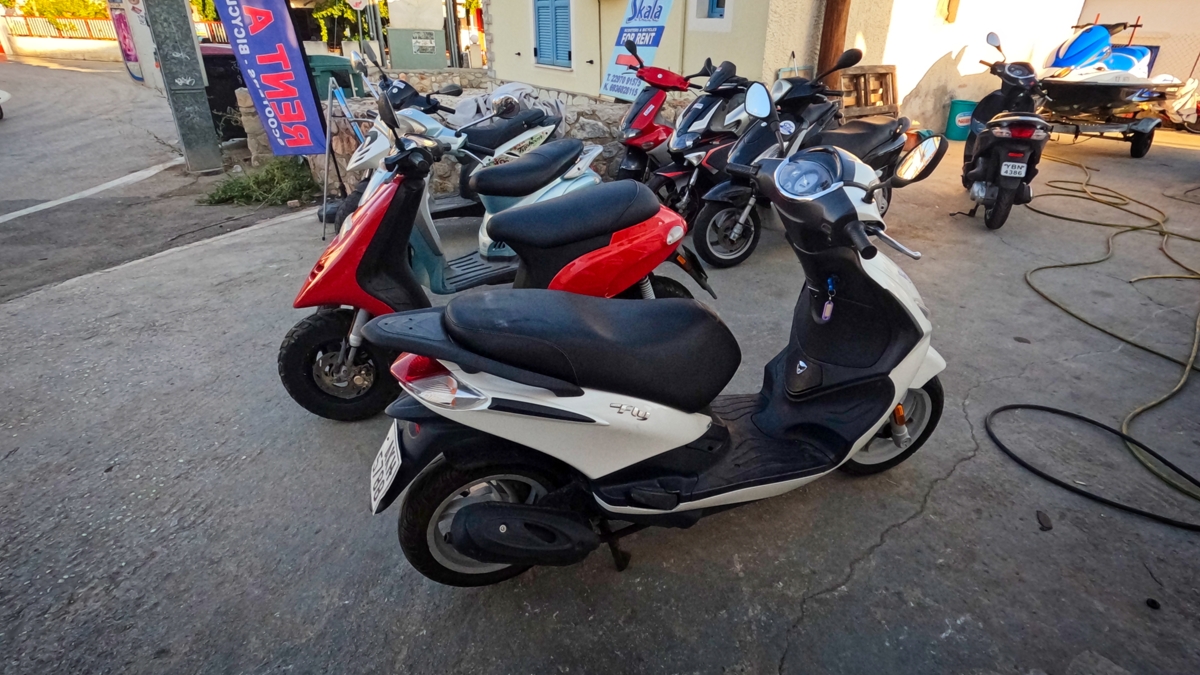
Why Choose a Moped?
✔ Budget-friendly – Lower rental and fuel costs than cars or ATVs.
✔ Great for remote areas – Access hidden beaches and small villages without worrying about parking.
✔ Ideal for quick trips – Perfect for zipping between attractions if you’re short on time.
Storage & Practicality
Unlike bicycles and e-bikes, most mopeds come with a small, lockable storage compartment under the seat. While this space is useful, it’s usually just big enough for a helmet, so don’t expect to store much else. If you’re carrying a bag, a small backpack or a crossbody bag works best.
Safety & Road Conditions
While mopeds offer freedom and fun, they do come with risks:
⚠ Greek roads can be rough, especially in rural areas where potholes and loose gravel are common.
⚠ Traffic can be unpredictable, especially in busy towns or near ports.
⚠ Helmets are required by law—always wear one, even if the locals don’t!
If you’re comfortable riding and prioritize safety, a moped is a fantastic way to explore Greek islands on a budget. Just double-check your license, inspect the vehicle before renting, and ride responsibly to make the most of your trip! 🏍🇬🇷
Exploring Greek Islands by ATV: Adventure on Four Wheels
If you’re looking for a fun, adventurous, and versatile way to explore the Greek islands, an ATV (quad bike) might be the perfect option. These rugged vehicles are a popular choice among tourists, offering stability on rough roads, the ability to access remote locations, and the thrill of off-road exploration—all without the need for a motorcycle license.
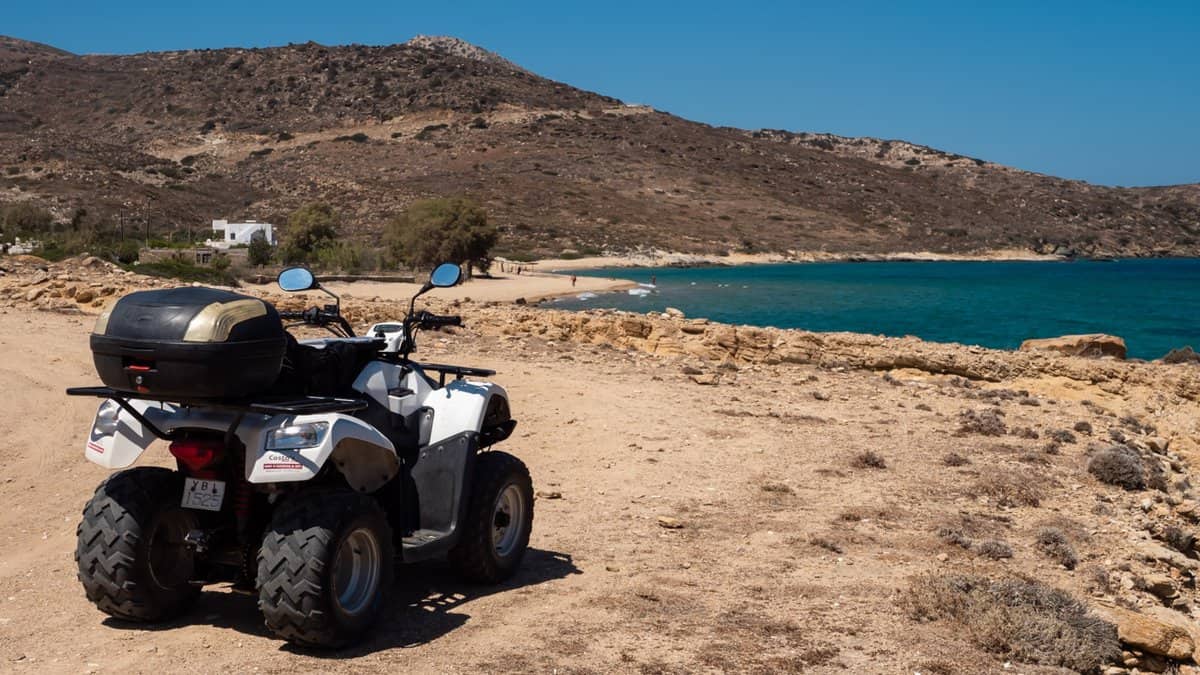
Why Choose an ATV?
ATVs combine the freedom of a motorbike with the stability of a car, making them a great middle-ground for those who want an exciting ride without worrying about balancing on two wheels. They’re ideal for:
✔ Reaching off-the-beaten-path locations – Some of Greece’s most beautiful beaches and villages are only accessible via dirt roads.
✔ Tackling rough terrain – Many islands have uneven, gravelly roads where ATVs perform better than scooters.
✔ Comfortable sightseeing – ATVs are easier to ride than motorbikes and feel safer for beginners, provided you ride at a safe speed.
While they offer greater safety than mopeds, they still require caution, especially on paved roads and in high-traffic areas.
ATV Rental Requirements: What You Need to Know
Before booking an ATV, make sure you meet the necessary requirements:
🏍 License Requirements – Most islands require at least a Category B (car) license to rent an ATV. Some may ask for an International Driving Permit (IDP) if your license is from outside the EU.
📅 Age Restrictions – Many rental companies won’t rent ATVs to drivers under 21, so check in advance.
🛑 Experience Recommended – While ATVs are easier to ride than motorbikes, they handle differently from cars, so take a test drive before heading out.
Cost & Fuel Efficiency
Renting an ATV is more expensive than a moped but cheaper than a car, making it a great compromise for adventurous travelers:
💰 Daily rental prices start at around €25-50, depending on engine size and season.
⛽ Fuel costs are moderate, but higher than mopeds—factor this into your budget if planning long-distance rides.
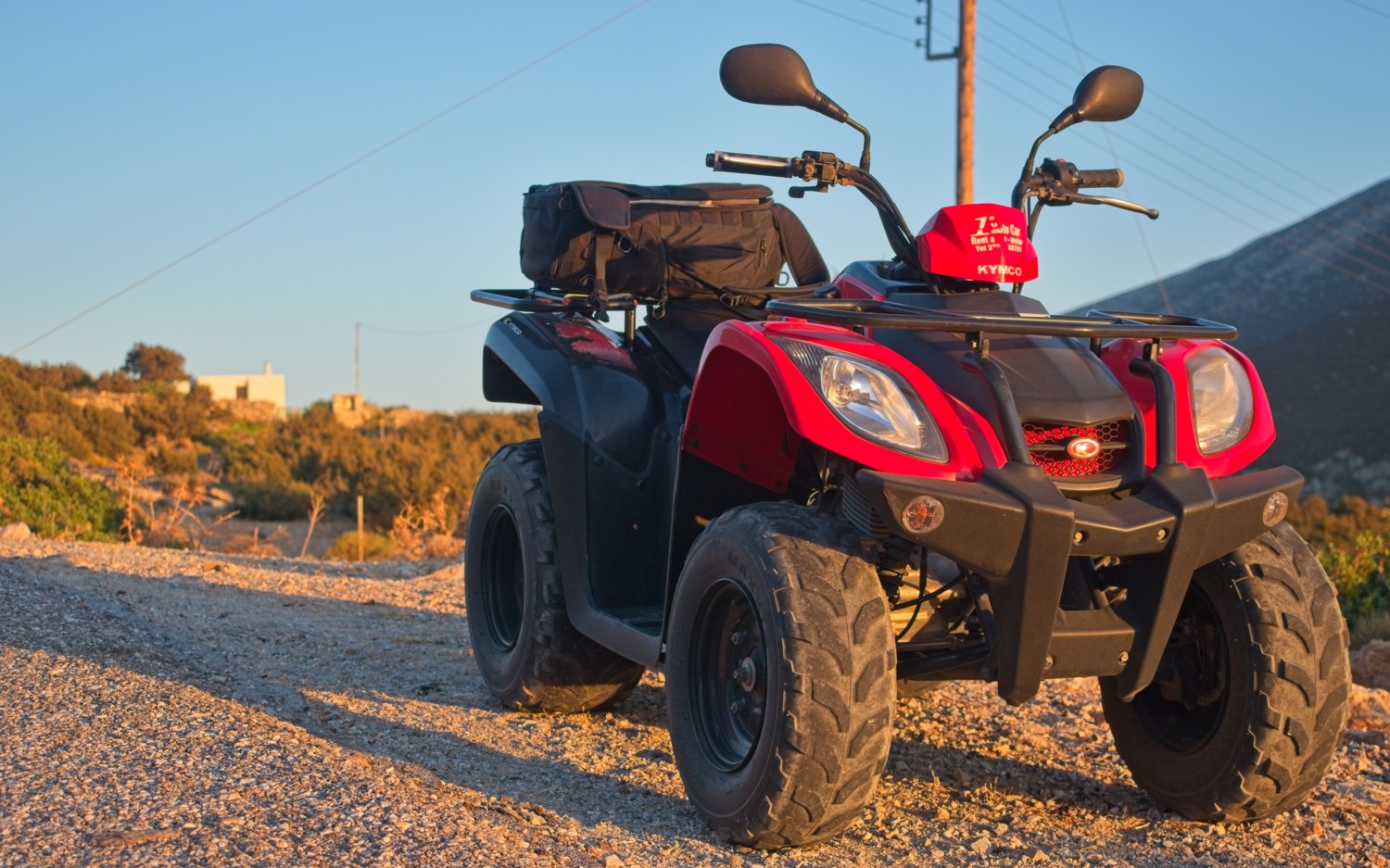
Storage & Practicality
ATVs have more storage space than bikes or mopeds, but less than cars. Most rentals come with:
🛄 A small rear rack – Useful for securing a small backpack.
🎒 A lockable compartment – Good for valuables but not very spacious.
Safety Tips for Riding an ATV in Greece
Although ATVs feel stable, they come with their own risks, so it’s important to ride responsibly:
⚠ Wear a helmet – This is required by law in Greece, even if you see others without one.
⚠ Drive carefully on paved roads – ATVs have a high center of gravity and can tip over easily on sharp turns.
⚠ Avoid busy traffic areas – Stick to back roads where possible to enjoy the ride without stress.
⚠ Watch out for wind & terrain – Strong winds on islands like Santorini or Mykonos can make handling an ATV trickier than expected.
⚠ Never carry more than one passenger – It’s illegal to have more than two people on an ATV and can make them dangerous and hard to control. Don’t take the risk.
Is Renting an ATV Worth It?
ATVs are a fantastic choice for adventurous travelers who want:
✔ The freedom to explore hidden gems.
✔ A fun alternative to cars or mopeds.
✔ Better stability on rough roads.
However, if you plan to do a lot of highway driving or have little experience with ATVs, you may prefer renting a car or scooter instead.
With the right precautions, renting an ATV can be one of the most exciting ways to experience a Greek island—so buckle up, stay safe, and enjoy the ride! 🏝🏍🇬🇷
Exploring Greek Islands by Car: The Ultimate Freedom
For travelers who want comfort, convenience, and the ability to explore without limitations, renting a car is the best option. While public transport, mopeds, and ATVs work for many tourists, a car provides better protection from the elements, more storage space, and the flexibility to go anywhere on your own schedule.
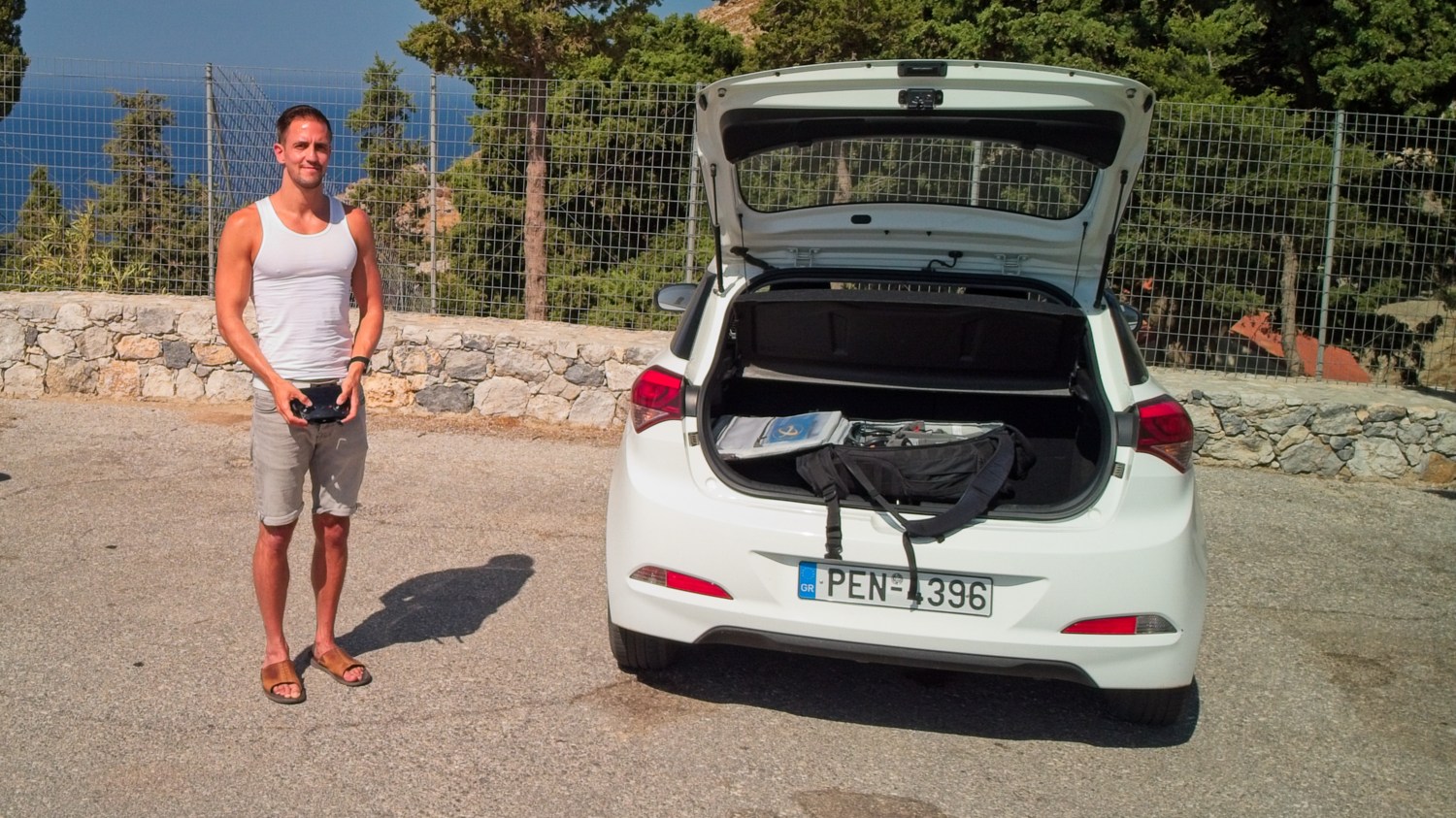
Why Rent a Car in Greece?
🚗 Comfort & Convenience – No need to worry about heat, sunburn, or exhaustion from long rides.
🗺 Explore at Your Own Pace – No waiting for buses or worrying about taxi availability.
🧳 Plenty of Storage – Ideal for families or groups carrying luggage, beach gear, or groceries.
🌦 Weather Protection – Greece can be hot and windy, making a car the most comfortable way to travel.
While a car isn’t always necessary on smaller islands, it’s a great option for larger or more rugged destinations like Crete, Rhodes, Corfu, or Naxos.
Car Rental Requirements: What You Need to Know
Before booking a rental, make sure you meet Greece’s driving requirements:
🏎 License Requirements – Most rental agencies require a Category B (car) license. If you’re from outside the EU, you’ll likely need an International Driving Permit (IDP) in addition to your home license.
📅 Age Restrictions – The minimum age to rent a car is 21, but many companies charge extra fees for drivers under 25.
🚦 Driving Experience – Some companies require at least one year of driving experience before renting to you.
Car Rental Costs: What to Expect
Renting a car is more expensive than mopeds or ATVs, but if you’re traveling as a group or family, it can actually save money by avoiding regular taxi fares or renting multiple smaller vehicles.
💰 Daily Rental Prices:
- Small economy cars: €30-50 per day
- SUVs or 4x4s: €60+ per day
- Peak season (July-August) can push prices even higher.
⛽ Fuel Costs:
- Petrol prices in Greece are higher than in many European countries, so budget accordingly.
- Some rental companies provide cars with a full tank policy (return it full) or a prepaid fuel option (return it empty). It’s usually cheaper to refuel it yourself, but if you want to avoid the hassle of filling up before handing the car back, the prepaid option might suit you better.
🛑 Additional Fees:
- One-way rentals (picking up and dropping off at different locations) may cost extra.
- Car ferries between islands are possible but often come with high fees—check with the rental company before planning inter-island trips as their insurance may not cover taking the vehicle off the island or on a ferry.
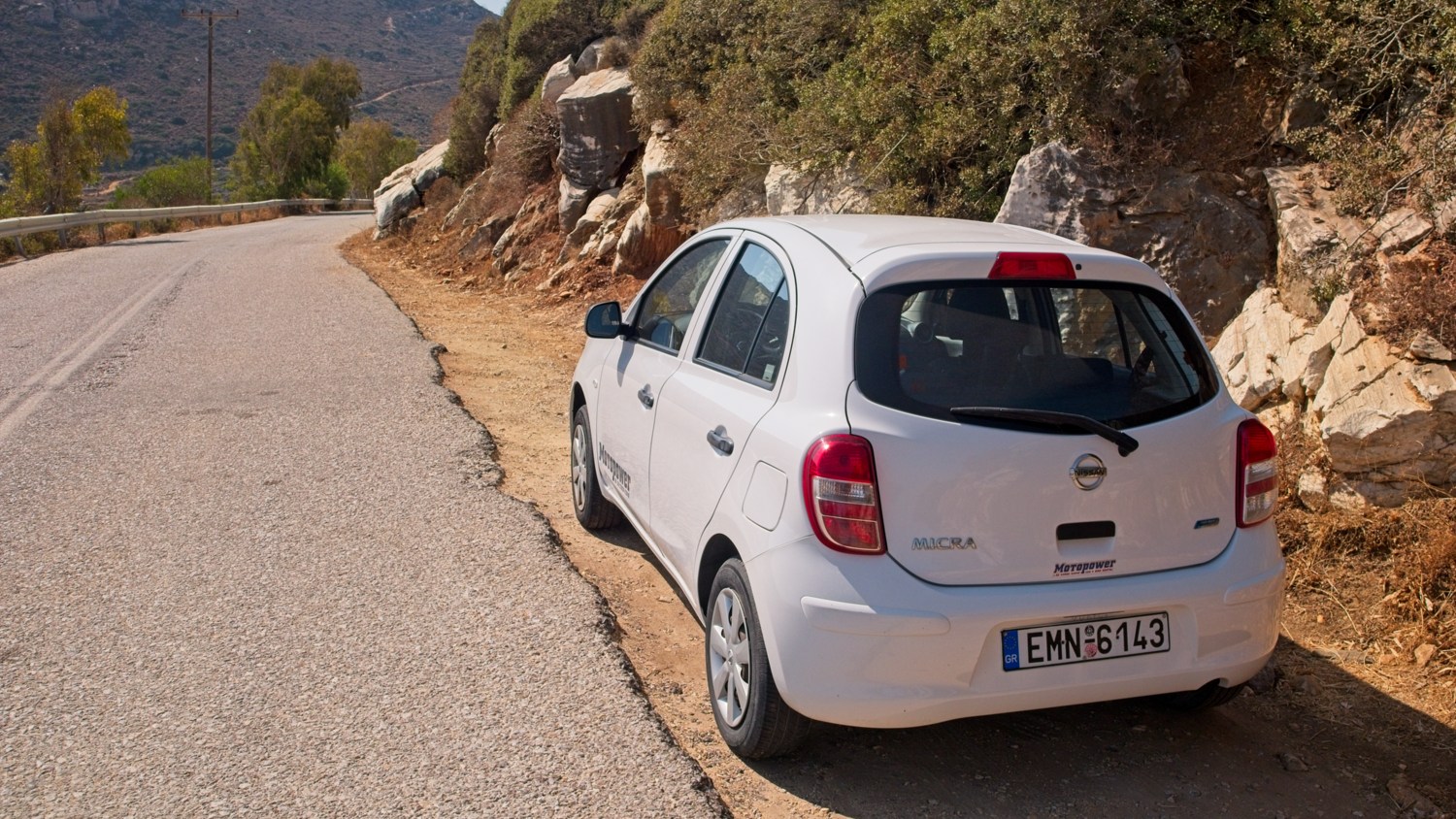
Where to Rent a Car in Greece
🚗 Airports & Ports – Most major Greek islands have rental agencies at their airports and ferry ports, making pick-up easy.
🏨 Hotels & Local Agencies – Many hotels partner with car rental companies and can arrange bookings for you.
💻 Online Reservations – Booking in advance (especially in peak season) is recommended to secure a good price and ensure availability.
Road Conditions & Driving in Greece
While Greek roads are generally well-maintained in cities and popular tourist areas, driving on the islands comes with unique challenges:
⚠ Narrow, Winding Roads – Many island roads are steep and curvy, requiring cautious driving.
⚠ Limited Street Lighting – Roads outside major towns often lack lighting, making night driving riskier.
⚠ Unpaved & Dirt Roads – Some of the best beaches (like Balos Beach in Crete) require a 4×4 or high-clearance vehicle.
⚠ Greek Driving Style – Local drivers can be aggressive—expect fast overtaking and minimal use of indicators.
🚦 Driving Tips:
✔ Drive defensively and expect unexpected turns, pedestrians, and even animals on the road.
✔ Avoid parking in unauthorized spots—many towns have limited parking, and fines are common.
✔ Some remote beaches require off-road driving—if you’re planning to visit these, rent an SUV or a 4×4.
Is Renting a Car Worth It?
✅ Best for:
✔ Exploring large islands like Crete, Rhodes, or Corfu, where distances are long.
✔ Traveling with family or a group—more affordable than multiple taxis.
✔ Visiting remote beaches and villages that aren’t well-served by public transport.
❌ Not Ideal for:
✖ Small islands like Hydra or Symi, where cars are unnecessary.
✖ Visitors uncomfortable with narrow, winding roads or aggressive driving styles.
✖ Short stays where public transport or taxis are more convenient.
Renting a car is the most comfortable way to explore the Greek islands, especially if you want freedom, flexibility, and storage space. If you’re confident driving on narrow and sometimes rugged roads, a car lets you reach hidden gems, scenic viewpoints, and secluded beaches without relying on schedules or taxis.
Just book in advance, check your license requirements, and drive cautiously—then enjoy discovering Greece on your own terms! 🚗🇬🇷

